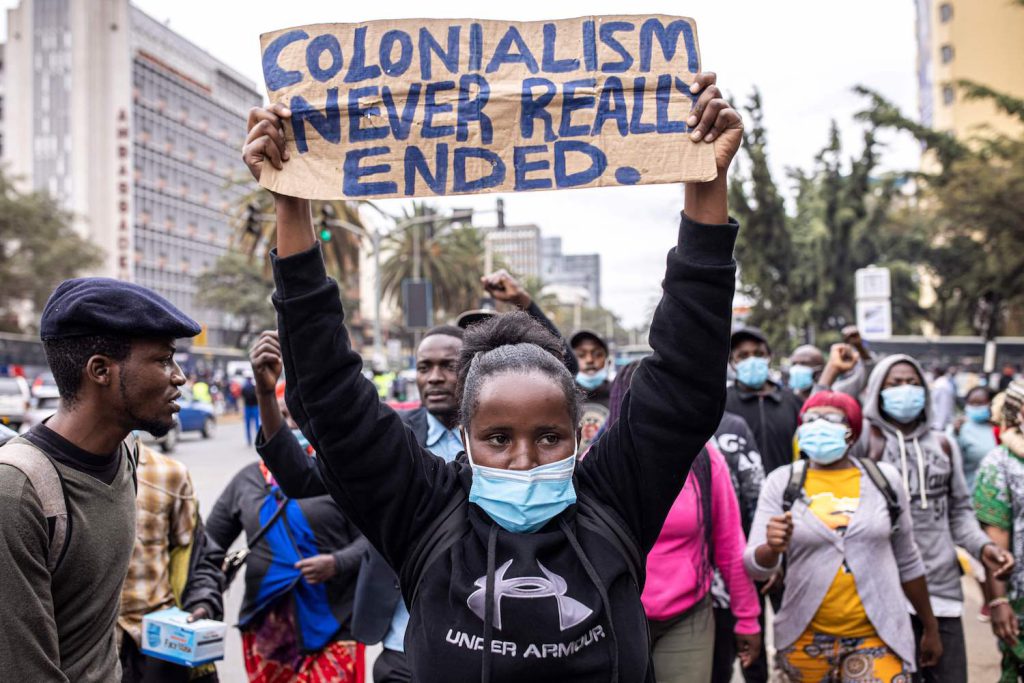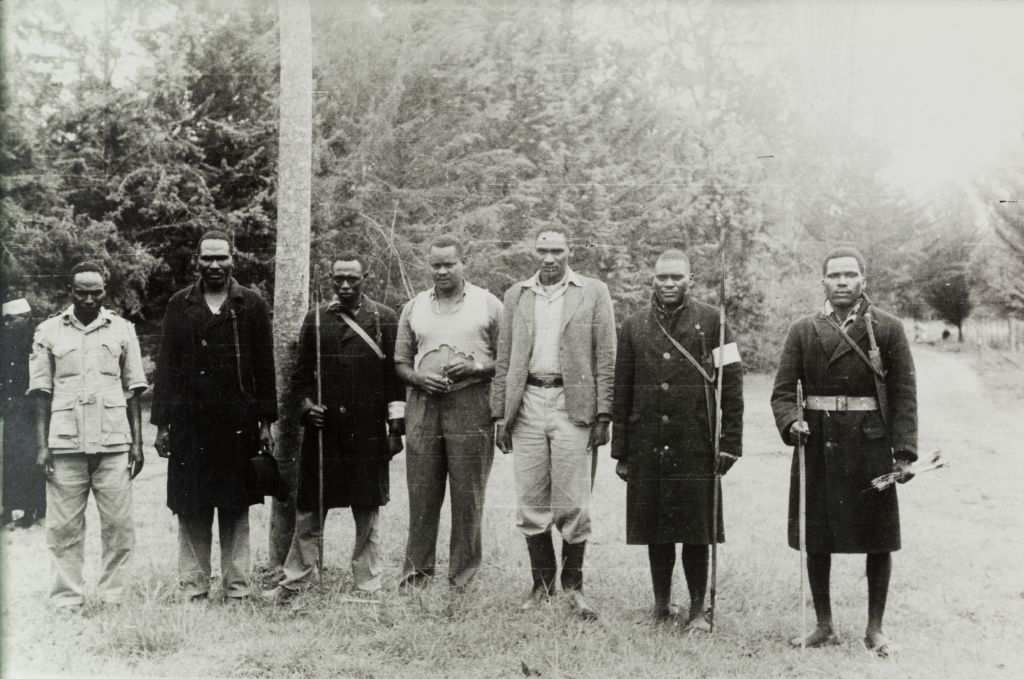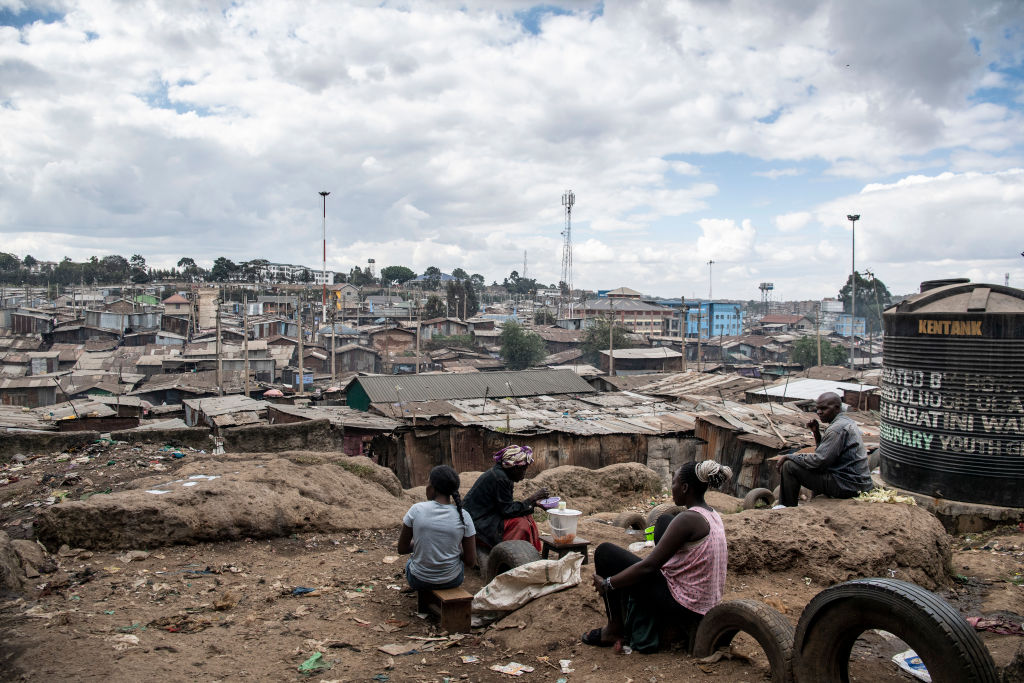What Kenya’s Killer Cops Reveal About Police Culture

In February 2021, several teenagers were talking and smoking on a street in Mathare, one of Nairobi’s many informal settlements. Suddenly, a group of armed plainclothes police officers approached. One of them, known only as “Baraza,” was a notorious “killer cop,” an officer operating in parallel to normal police who often commits extrajudicial executions in informal settlements, ostensibly to curb crime.
An officer shot toward the teenagers, and one young man, Dominic Kulema, was hit with a bullet. He ran into a baze, a small youth center where they hang out. The police followed. Severely injured, Kulema pleaded to be arrested rather than killed. Instead, Baraza and his team forced him out of the building and shot him once more, killing him.
This story didn’t even make national headlines, let alone international news. In fact, it is part of a normalized pattern in Nairobi: police killing young men who have not been charged with any crime.
When the murder of George Floyd in the U.S. in May 2020 sparked global uprisings against police violence, Kenyans also mounted greater public demands for accountability through grassroots organizing and a series of anti–police-brutality demonstrations. However, these protests have not been met with fewer killings or a significant change in police operations.
In 2020, police killed or disappeared 167 people, according to Missing Voices Kenya, a consortium of human rights organizations tracking extrajudicial killings.
“We want to honor every life, but there are so many [killings],” says Wangui Kimari, an urban ethnographer who co-founded a social justice center in Mathare. “They become blurred in your mind because there are so many. Some we don’t even announce because it just happens so fast.”
Kenya’s government has repeatedly launched well-funded attempts at police reform. Yet violent police practices seem impervious, especially those of killer cops.
Several anthropologists are studying police violence in Nairobi, in part to determine why brutality has resisted reform. Their research is revealing causes rooted specifically in Kenya’s colonial history. But they are also uncovering problems that countries around the world face in their efforts to reform policing—from the myth of the “bad apple” cop to “us and them” narratives about who deserves to live or die.
The foundations of Nairobi’s social divisions and brutal, bifurcated policing system were laid in the first few decades of its existence. In 1899, Great Britain established the settlement as a rail depot in a swampy yet strategic stretch of land between the port of Mombasa and the Nile River. In a few years, Nairobi was christened the capital of Britain’s East Africa Protectorate.
Though the city was not formally segregated, the European settlers separated themselves, laying claim to higher-elevation areas in the west and relegating African workers to dense, unsanitary barracks in the low-lying, malaria-prone east. Colonists treated the African districts as temporary holding spaces for low-wage laborers, so they intentionally failed to develop basic infrastructure.
In 1920, the same year Kenya became an official colony, the British established the Kenyan Police Force. African men were required to wear a box around their neck containing their name, tribe, and employer. Police forces and civilian employers monitored and controlled their movement within the city. Administrators had the power to evict, arrest, or expel African workers.
In the 1950s, the Kenya Land and Freedom Army, comprised largely of landless Africans from central Kenya, organized and fought for the repatriation of stolen land, terrorizing white settlers. After some settlers organized local vigilantes to protect themselves, the administration formally enlisted a Home Guard, comprised of native Africans who worked on behalf of the colonial government and were given authority to enforce the law, often very brutally. The administration instated quasi–martial law. The Home Guard was later formalized as the Administration Police (AP), a paramilitary unit that would “deal with matters of customary law”—in other words, “natives.”
The existence of the dual system persisted even after Kenya gained independence from Britain in 1963. Up until 2019, when the AP was absorbed into the National Police Force, the AP primarily conducted raids, while the Kenya Police engaged in more “everyday” forms of policing, particularly for affluent residents.
With the existence of killer cops, Kenya’s bifurcated policing system continues. It is not clear how exactly killer cops emerged, nor who oversees them. But it is certain they operate outside formal avenues of accountability.
Though killer cops may seem like an extreme form of police brutality, aspects of Kenya’s unequal policing methods are mirrored in other countries. Some police reform advocates say the U.S. has a dual law-enforcement system: Many citizens are policed with democratic methods, while some minority groups are treated like colonial subjects that are controlled with military-like force.
As it does in Kenya, the specter of colonialism and violent policing also haunts law enforcement agencies in other places. In Hong Kong, another former British colony, punitive corporal punishment was meted out unequally (with Chinese convicts receiving much heavier penalties than their European counterparts). The British colonial Hong Kong Police Force (HKPF) became a key testing ground for extreme policing techniques, like tear gassing civilians.
The British used their strategy of policing and suppressing the Kenya Land and Freedom Army as a template for suppressing the Irish Republican Army starting in 1969. And the modern HKPF—along with many other police forces around the world—continue to use techniques the HKPF innovated decades ago. One such technique is “kettling,” a method of trapping demonstrators in a confined area and then making arrests. This tactic was frequently used in the U.S. during the racial justice protests of 2020.
Such harsh policing methods—including killings—are part of a larger problem of societal inequality, in Kenya and beyond.
On the day Kulema died, his friend Collins witnessed everything. Collins immediately approached the Mathare Social Justice Centre (MSJC), a grassroots organization comprised primarily of Mathare residents that was co-founded by anthropologist Kimari.
MSJC has been tracking such stories for years, relying on community-sourced information to document killings or enforced disappearances that the media do not report. In 2017, MSJC released a first-of-its-kind report about the epidemic of police killings in Nairobi.
The paper documented what Kimari calls “the systematic annihilation of young people.” Young men, not convicted of any crime, are executed in their own homes, on the way to work, or hanging out with friends.
But this grassroots organization can barely keep up with all the extrajudicial executions. The group’s emergency tweets—which once led to a lifesaving phone call as the victim was on his knees with a gun pointed at his head—form a live blotter of the everyday violence. In February 2021 alone, MSJC documented at least 14 killings. That does not include cases in other informal settlements in Nairobi, or the many violent incidents that were never recorded.
While victims of the brutality are typically young men, even families of the deceased become targets of police harassment or violence. In addition, widely documented evidence points to police committing sexual violence, particularly against women and LGBTQI people.
Read more about grassroots activism in our photo essay, “Kenyan Mothers Take on Police Violence.”
Kimari believes the violence can be understood in part as a structural problem. Nairobi’s segregated urban design has changed little from the colonial period. As of 2014, more than half of the city’s roughly 4 million residents live in informal settlements.
People in these areas do not enjoy publicly provided services that the government avails to affluent areas, such as electricity, sewage and waste management, water, and maintained roads. To access these utilities, they must pay exorbitant rates to cartels. Communities are subjected to a completely different form of governance than other parts of Nairobi. As one human rights defender says, in Mathare, the Constitution does not work.
Kimari has captured the plight of people in these settlements with a deft double-entendre: Those who have inherited the neglected native quarters of the colonial city are made “outlaws” in two senses. They are “pushed outside of the law since they are not habitually privy to the most basic rights enshrined in the Constitution.” They are also outlawed—consistently criminalized and subjected to a brutal form of policing reserved only for people the city sees as disposable.
In lieu of basic services, violent policing provides the “de facto forms of urban infrastructure” that shape how people move and live. It helps maintain a status quo for Nairobi, including a pool of cheap labor for wealthier residents.
But police don’t just control the movement of poor people into rich neighborhoods. “They enforce who gets basic services and who doesn’t,” Kimari explains. “If the Nairobi City Sewerage and Water Company comes to Mathare, they come with the police. Or stima [electricity]. Mlango Kubwa [one of Mathare’s six wards] didn’t have stima for three months; police are part of that process. If you’re evicted, police are there. Water, they’re there too. It’s not just surveillance of borders, it also comes down to infrastructure.”
Anthropologist Tessa Diphoorn, who also studies the city’s policing, agrees with Kimari. “Police are doing things in Mathare that are not their task. It’s not their task to provide water,” she observes. “But there is this kind of vacuum.” So, these roles fall to police officers.
Again, these issues aren’t unique to Kenya. Many countries lack dedicated responders for a variety of social issues. So police are called in to handle mental health crises, noise complaints, children misbehaving in class, and more. Some experts—including anthropologists and law enforcement officers themselves—argue that giving police such broad roles can lead to unnecessary force. Law reform advocates often point to successes in European countries where some police responsibilities have been replaced by mental health teams, support networks for homeless people, and other services that can help communities improve without the threat of violence.
But reforming law enforcement systems is a monumental task that requires not only structural changes but also overcoming widespread prejudices and myths about policing.
Kenya has tried repeatedly to reform its police system. But efforts to make the police more accountable and to stop politicians from employing police to persecute political opponents and intimidate voters, for example, have failed miserably.
Even after these efforts began in the early aughts, police took part in at least two major crackdowns. During the wave of political and ethnic violence that followed the contested 2007 general election, police were involved in more than 400 deaths. From 2004 to 2009, the government sought to dismantle the Mungiki, an ethnonationalist group that had amassed enough power in parts of Nairobi—for example, violently enforcing the collection of “protection fees”—that it rivaled the state’s authority. The government claimed this group was involved in post-election violence.
According to a 2007 report published by the Oscar Foundation, a legal clinic that documented systematic extrajudicial executions, police had killed more than 8,000 people since 2002. The following year, the report’s authors, Oscar King’ara and George Paul Oulu, were assassinated in broad daylight.
To understand why police reforms in Kenya have not worked, anthropologist Diphoorn focused on internal attitudes among police. Between August 2017 and August 2018, she conducted approximately 180 interviews, including 75 formal interviews with police officers, a third of whom worked at reform-oriented agencies.
She found that police reform overwhelmingly focused on cultivating a culture that prevents “pure apples” from becoming “rotten apples.” Much of the 2011 National Police Service Act, for example, breaks down the borders between police departments to facilitate supervision, as well as formalize methods for “correcting” poor-performing officers.
Diphoorn’s interviewees within the police force expressed a “conviction that reform should come from ‘within,’ from police officers, and thus not from external donors or civilians.” But this was often expressed in terms of officers’ individual morality and improvement, and the idea that “pure apples” could be trained into being—not a recognition that violent policing was systemic.
The “rotten apple” or “bad apple” narrative is used to explain police misconduct in countries around the world, including the U.S. and the U.K. Critics say this tactic of scapegoating “rogue” police is a way to defend the current system and distract from systemic problems in policing. Despite the tendency to blame individual “bad apples,” several federal investigations throughout the U.S., for example, have revealed that brutal racial discrimination and patterns of excessive force in policing are the result of “systematic deficiencies.”
Another important dynamic allowing police brutality to persist—in Kenya and other places—is the public’s tacit condonation of violence in certain cases. Put bluntly, it’s the idea that a “thug” deserves extrajudicial execution. Anthropologist Naomi van Stapele has studied the moral borders that define which murders incite public outrage and which are condoned.
“[Moral bordering] was a lens that helped me zoom in and make something more visible, to understand why [condonation of police killings] was so localized and why it was framed in a moral discourse, and why it was also phrased with such violent words, like, ‘They deserved to die’—saying, literally, physically, ‘They’re not supposed to be here,’” van Stapele explains.
Kenya’s government deems police killings as a valid, effective way to manage crime, especially by deterring potential future criminals. Subsequently, van Stapele discovered, the wider public has bought into “legitimating narratives that these young men embody an imminent threat to society at large.”
Killer cops look less like rogues than actors in a system that sanctions violence to preserve the hierarchy.
She notes that if the number of police killings that occur in poor neighborhoods happened in affluent areas, it would constitute a terrorist attack. Yet Nairobi’s comfortable class legitimizes police killings when victims are “thugs.”
Similarly, residents of informal settlements draw boundaries within their communities to create “permissive spaces for police killings.” A place like Mathare is far from homogeneous; rather, it is a patchwork of groups of varying ethnicities, religions, generations, and political leanings.
In her study of the Mlango Kubwa ward of Mathare, van Stapele observed a duality between born-and-bred Mathare “natives” and “newcomers.” Mathare natives see newcomers as opportunistic, stealing work that belongs to natives. Newcomers, in turn, frame natives as criminal and lazy. Newcomers often collaborate with police, including killer cops, to provide intelligence in order to root out crime from their neighborhoods.
As van Stapele puts it, “killing ‘others’ marks out who belongs and who does not.”
Once we understand the culture of exclusion that shapes informal settlements, van Stapele writes, killer cops look less like rogues than actors in a system that fosters and sanctions violence to preserve the hierarchy. So long as it is legitimate to extrajudicially execute “them,” there will always be a “them” to execute. Until that logic is dismantled, no amount of reform will have the necessary public endorsement to end extrajudicial executions and police brutality.
Two months after Collins witnessed his friend’s murder, Collins himself was abducted by a killer cop known as “Njoro” and was thrown into the trunk of a Toyota Probox. Later that day, two more young men were detained in the same vehicle. MSJC raised the alarm over these illegal detainments in a series of tweets.
Public outrage—and a phone call from the director of an international human rights organization—led to police sparing the lives of the two men detained after Collins. They were brought instead to a police station. Collins, however, was murdered.
Kenya’s 2011 National Police Service Act states that lethal force is only justified when strictly unavoidable to protect life and that officers who use lethal fire must report so to their superiors. Yet witness accounts of police killings overwhelmingly reveal victims pleading for their lives, putting their hands up, and/or trying to escape when they are fatally shot.
Increasingly, police are using these methods to execute witnesses to their own violence. Instead of shooting victims in the light of day, killer cops often abduct their targets, keep them in the trunk of a vehicle, and wait until nightfall to execute them, according to human rights groups and Kenyan media. Many young men who had not been formally charged or convicted of any crime were seen alive for the last time in the same Toyota Probox that trapped Collins.
When it comes to curbing these deadly acts and dismantling the “us and them” narratives that allow them to persist, organizing at the grassroots level has been crucial.
Kimari says that when MSJC held its first community dialogue on police killings in Mathare in 2015, people were incredulous that anyone would dare speak about such a sensitive topic so openly—something that had proven fatal for many activists in the past (and, tragically, still continues to be).
But such events have been key to de-normalizing these killings at a community level. The information MSJC receives about executions or abductions comes from people in the community, Kimari says. “Mtaani people give you cops [cops’ names], direction, location, number plate. People are really attentive to that.”
Diphoorn also agreed that, although killings continue, there has been a sea change. “Police officers said this to me: that they do fear more now about certain repercussions, about what will happen, and have said that 10 years ago, this was not there at all. [They say,] ‘Now, I do think a little bit more when I do something.’ These are slow changes.”



































